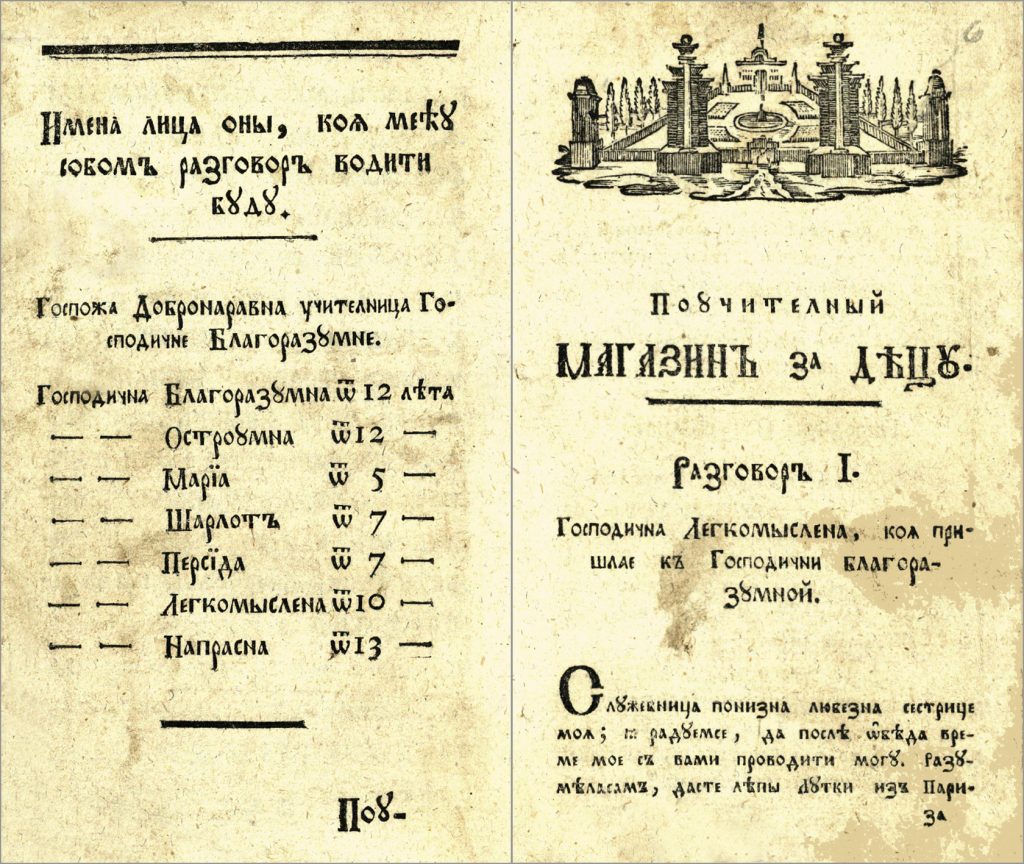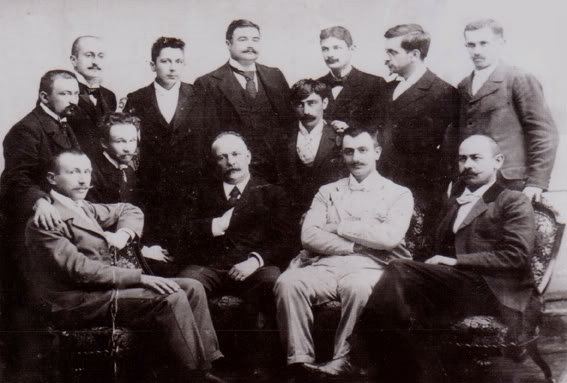|
Slavonic-Serbian
Slavonic-Serbian (славяносербскій, ''slavjanoserbskij''), Slavo-Serbian or Slaveno-Serbian (славено-сербскiй, ''slaveno-serbskij''; , ''slavenosrpski''), was a literary language used by the Serbs in the Habsburg Empire, mostly in what is now Vojvodina, from the mid-18th century to the first decades of the 19th century, falling into obscurity by the 1870s. It was a linguistic blend of Church Slavonic of the Russian recension, vernacular Serbian ( Shtokavian dialect), and Church Slavonic of the Serbian recension, with varying sources and differing attempts at standardisation. History At the beginning of the 18th century, the literary language of the Serbs was the Serbian recension of Church Slavonic (also called Serbo-Slavonic), with centuries-old tradition.Albin 1970, p. 484Ivić 1998, pp. 105–106 After the Great Serb Migration of 1690, many Serbs left Ottoman-held territories and settled in southern areas of the Kingdom of Hungary in the Hab ... [...More Info...] [...Related Items...] OR: [Wikipedia] [Google] [Baidu] |
German–Serbian Dictionary (1791)
The 1791 German–Serbian dictionary, referred to as the Avramović Dictionary ( or ''Avramovićev rečnik''; full title in ; full title in Slavonic-Serbian: Нѣмецкïй и сербскïй словарь на потребу сербскагѡ народа въ крал. державахъ, transliterated as ''Německij i serbskij slovar' na potrebu serbskago naroda v kral deržavah'', meaning "German and Serbian Dictionary for Use by the Serbian People in the Royal States"), is a historical bidirectional translation dictionary published in the Habsburg Empire's capital of Vienna in 1791, though 1790 is given as the year of publication in some of its copies. Containing around 20,000 headwords in each direction, it is the largest Serbian dictionary of the 18th century. Vuk Karadžić possibly used it as a source for his '' Serbian Dictionary'', which first appeared in 1818 as the first book in modern literary Serbian. The Avramović Dictionary translates between Slavonic-Serbia ... [...More Info...] [...Related Items...] OR: [Wikipedia] [Google] [Baidu] |
Literary Language
Literary language is the Register (sociolinguistics), register of a language used when writing in a formal, academic writing, academic, or particularly polite tone; when speaking or writing in such a tone, it can also be known as formal language. It may be the Standard language, standardized variety of a language. It can sometimes differ noticeably from the various spoken language, spoken Variety (linguistics), lects, but the difference between literary and non-literary forms is greater in some languages than in others. If there is a strong divergence between a written form and the spoken vernacular, the language is said to exhibit diglossia. The understanding of the term differs from one linguistic tradition to another and is dependent on the terminological conventions adopted. Literary English For much of its history, there has been a distinction in the English language between an elevated literary language (written) and a colloquialism, colloquial or vernacular language (sp ... [...More Info...] [...Related Items...] OR: [Wikipedia] [Google] [Baidu] |
Vuk Karadžić
Vuk Stefanović Karadžić ( sr-Cyrl, Вук Стефановић Караџић, ; 6 November 1787 (26 October OS)7 February 1864) was a Serbian philologist, anthropologist and linguist. He was one of the most important reformers of the modern Serbian language. For his collection and preservation of Serbian folktales, ''Encyclopædia Britannica'' labelled Karadžić "the father of Serbian folk-literature scholarship." He was also the author of the first Serbian dictionary in the new reformed language. In addition, he translated the New Testament into the reformed form of the Serbian spelling and language. He was well known abroad and familiar to Jacob Grimm, Johann Wolfgang von Goethe and historian Leopold von Ranke. Karadžić was the primary source for Ranke's ''Die serbische Revolution'' (" The Serbian Revolution"), written in 1829. Biography Early life Karadžić was born to Serbian parents Stefan and Jegda (née ''Zrnić'') in the village of Tršić, near Loznica, ... [...More Info...] [...Related Items...] OR: [Wikipedia] [Google] [Baidu] |
Serbs
The Serbs ( sr-Cyr, Срби, Srbi, ) are a South Slavs, South Slavic ethnic group native to Southeastern Europe who share a common Serbian Cultural heritage, ancestry, Culture of Serbia, culture, History of Serbia, history, and Serbian language, language. They primarily live in Serbia, Kosovo, Bosnia and Herzegovina, Croatia, Montenegro as well as in North Macedonia, Slovenia, Germany and Austria. They also constitute a significant diaspora with several communities across Europe, the Americas and Oceania. The Serbs share many cultural traits with the rest of the peoples of Southeast Europe. They are predominantly Eastern Orthodoxy, Eastern Orthodox Christians by religion. The Serbian language, Serbian language (a standardized version of Serbo-Croatian) is official in Serbia, co-official in Kosovo and Bosnia and Herzegovina, and is spoken by the plurality in Montenegro. Ethnology The identity of Serbs is rooted in Eastern Orthodoxy and traditions. In the 19th century, the ... [...More Info...] [...Related Items...] OR: [Wikipedia] [Google] [Baidu] |
Serbian Literature
Serbian literature ( sr-Cyrl, Српска књижевност, ''Srpska književnost''), refers to literature written in Serbian language, Serbian and/or in Serbia and all other Serbian diaspora, lands where Serbs reside. The history of Serbian literature begins with the independent works from the Serbia in the Middle Ages, Nemanjić dynasty era, if not before. With the fall of Serbia and neighboring countries in the 15th century, there is a gap in the literary history in the occupied land. Serbian literature, however, continued uninterrupted in Serbian-inhabited lands under European rule and saw Serbian Revival, a revival with Baroque works published in the 18th century in what is today Vojvodina. Serbia gained independence following the Serbian Revolution (1804–1815) and Serbian literature has since prospered. Several Serbian writers have achieved international fame. History Medieval and post-medieval literature ;Medieval Old Church Slavonic literature was crea ... [...More Info...] [...Related Items...] OR: [Wikipedia] [Google] [Baidu] |
Vojvodina
Vojvodina ( ; sr-Cyrl, Војводина, ), officially the Autonomous Province of Vojvodina, is an Autonomous administrative division, autonomous province that occupies the northernmost part of Serbia, located in Central Europe. It lies within the Pannonian Basin, bordered to the south by the national capital Belgrade and the Sava and Danube Rivers. The administrative centre, Novi Sad, is the second-largest city in Serbia. The historic regions of Banat, Bačka, Syrmia and northernmost part of Mačva overlap the province. Modern Vojvodina is multi-ethnic and multi-cultural, with some 26 ethnic groups and six official languages. Fewer than two million people, nearly 27% of Serbia's population, live in the province. Name ''Vojvodina'' is also the Serbian word for voivodeship, a type of duchy overseen by a voivode. The Voivodeship of Serbia and Banat of Temeschwar, Serbian Voivodeship, a precursor to modern Vojvodina, was an Austrian province from 1849 to 1860. Its official name ... [...More Info...] [...Related Items...] OR: [Wikipedia] [Google] [Baidu] |
Croatian Encyclopedia
The ''Croatian Encyclopedia'' () is a Croatian general encyclopedia An encyclopedia is a reference work or compendium providing summaries of knowledge, either general or special, in a particular field or discipline. Encyclopedias are divided into article (publishing), articles or entries that are arranged Alp ... (with the national component), published in 1999–2009 by the Miroslav Krleža Institute of Lexicography. Overview The project began in 1999, and it represents a fifth iteration of the encyclopedic tradition that was established by Mate Ujević's ''Croatian Encyclopedia'', and continued in the '' Encyclopedia of the Lexicographical Institute'', as well as the two editions of its ''General Encyclopedia''. Eleven volumes were published in the period 1999–2009, with a new volume appearing every year. It is named "Croatian" encyclopedia (colloquially ''Croatica'') in the tradition of general-knowledge encyclopedias as ''Britannica''. Online edition The f ... [...More Info...] [...Related Items...] OR: [Wikipedia] [Google] [Baidu] |
Russian Language
Russian is an East Slavic languages, East Slavic language belonging to the Balto-Slavic languages, Balto-Slavic branch of the Indo-European languages, Indo-European language family. It is one of the four extant East Slavic languages, and is the native language of the Russians. It was the ''de facto'' and ''de jure'' De facto#National languages, official language of the former Soviet Union.1977 Soviet Constitution, Constitution and Fundamental Law of the Union of Soviet Socialist Republics, 1977: Section II, Chapter 6, Article 36 Russian has remained an official language of the Russia, Russian Federation, Belarus, Kazakhstan, Kyrgyzstan, and Tajikistan, and is still commonly used as a lingua franca in Ukraine, Moldova, the Caucasus, Central Asia, and to a lesser extent in the Baltic states and Russian language in Israel, Israel. Russian has over 253 million total speakers worldwide. It is the List of languages by number of speakers in Europe, most spoken native language in Eur ... [...More Info...] [...Related Items...] OR: [Wikipedia] [Google] [Baidu] |
Zaharije Orfelin
Zaharije Orfelin ( sr-Cyrl, Захаријe Орфелин; 1726 – 19 January 1785) was a Serbs, Serbian polymath who lived and worked in the Habsburg monarchy and Republic of Venice, Venice. Considered a Renaissance, Renaissance man, he is variously described as a theology, theologist, scientist, poet, Engraving, engraver, Painting, painter, lexicography, lexicographer, Herbal medicine, herbalist, oenology, oenologist, historian, Publishing, publisher and Translation, translator. Biography He was born in a Serbs, Serb family in Vukovar in 1726, in the period after the Great Turkish War. His father's name was Jovan. Zaharije's nephew was the painter Jakov Orfelin. Orfelin's first published work was ''Краткоје о богоподобајуштем телу и крови Христовој поклоненији и временитога настављенија'', written during his scribal service as a scribe for the Metropolitan Nenadović in 1758. It is assume ... [...More Info...] [...Related Items...] OR: [Wikipedia] [Google] [Baidu] |
Pop-science
Popular science (also called pop-science or popsci) is an interpretation of science intended for a General reader, general audience. While science journalism focuses on recent scientific developments, popular science is more broad ranging. It may be written by professional science journalists or by scientists themselves. It is presented in many forms, including books, film and television documentaries, magazine articles, and web pages. History Before the modern specialization and professionalization of science, there was often little distinction between "science" and "popular science", and works intended to share scientific knowledge with a general reader existed as far back as Greek and Roman antiquity. Without these popular works, much of the scientific knowledge of the era might have been lost. For example, none of the original works of the Greek astronomer Eudoxus of Cnidus, Eudoxus (4th century BC) have survived, but his contributions were largely preserved due to the did ... [...More Info...] [...Related Items...] OR: [Wikipedia] [Google] [Baidu] |
Headword
In morphology and lexicography, a lemma (: lemmas or lemmata) is the canonical form, dictionary form, or citation form of a set of word forms. In English, for example, ''break'', ''breaks'', ''broke'', ''broken'' and ''breaking'' are forms of the same lexeme, with ''break'' as the lemma by which they are indexed. ''Lexeme'', in this context, refers to the set of all the inflected or alternating forms in the paradigm of a single word, and ''lemma'' refers to the particular form that is chosen by convention to represent the lexeme. Lemmas have special significance in highly inflected languages such as Arabic, Turkish, and Russian. The process of determining the ''lemma'' for a given lexeme is called lemmatisation. The lemma can be viewed as the chief of the principal parts, although lemmatisation is at least partly arbitrary. Morphology The form of a word that is chosen to serve as the lemma is usually the least marked form, but there are several exceptions such as the use of th ... [...More Info...] [...Related Items...] OR: [Wikipedia] [Google] [Baidu] |





